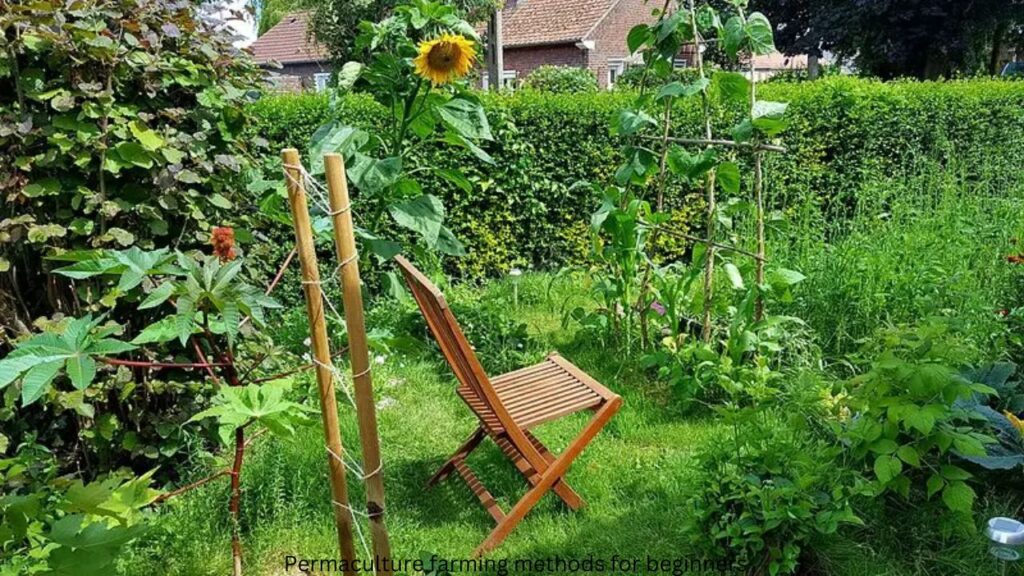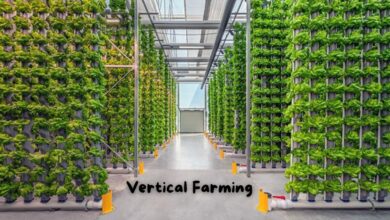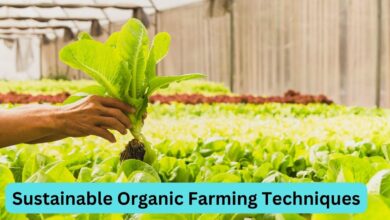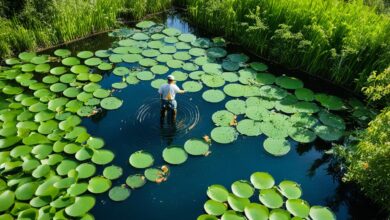Permaculture Farming Methods for Beginners: Start Now 2024
Permaculture farming methods for beginners Permaculture is a way to grow food that’s good for you and the planet. It’s perfect for beginners who want to be self-sufficient and take care of the earth. This guide will teach you everything you need to know to start your own permaculture garden or farm.
You’ll learn about the main ideas behind permaculture, like copying nature and using many different plants together. This knowledge will help you design your garden. You’ll find the best spot and plan your garden to work well.

Also Read : How to start a small organic farm : Your Complete Guide 2024
Then, we’ll talk about getting your soil ready, making compost, and planting things together. These steps are key to a garden that takes care of itself and produces a lot of food.
We’ll also cover how to manage water in your garden. You’ll learn about swales and earthworks to save water. By the end, you’ll be ready to start your own permaculture project. Your land will become a place that feeds you and helps the environment.
Understanding the Principles of Permaculture farming methods for beginners
Permaculture is a way to make farming and land care sustainable. It’s based on understanding how nature works. It uses nature’s patterns and diversity to create systems that can take care of themselves.
Mimicking Nature’s Patterns
Permaculture sees the world as connected and cyclical. Farmers try to copy nature’s ways. They aim for systems that use nutrients over and over, waste less, and use the good relationships between different plants and animals.
This method looks at nature for solutions. It leads to farms that are productive and need little help. It’s about making small changes and respecting nature’s wisdom.
Embracing Diversity and Resilience
Permaculture values diversity because it makes ecosystems strong. Instead of just one type of plant, permaculture gardens have many. This mix helps the soil, controls pests, and keeps the whole system stable.
With diversity, farms can bounce back from tough times. This is key for making food systems that can last through hard times. It’s about making sure food production can keep going, even when things get tough.
Learning about permaculture principles, permaculture design principles, and the permaculture philosophy is important for beginners. By using nature’s ways, they can make food systems that are productive, strong, and good for the environment.
Designing Your Permaculture Garden
Permaculture farming methods for beginners Creating a successful permaculture garden design means knowing your land well and designing it for efficiency and productivity. Think about the permaculture garden layout and permaculture zoning. This way, you can make a garden that works like nature does.
Choosing the Right Location
Permaculture farming methods for beginners Start by picking the best spot for your permaculture garden. Look at these things:
- Sun exposure – Find spots that get plenty of sunlight all day for your plants.
- Water access – Make sure you can easily get to a steady water source, like a well or stream.
- Soil quality – Check the soil to see where certain crops or plants will grow best.
- Slope and drainage – Think about the land’s slope and drainage to avoid water problems or soil washing away.
Mapping Out Zones and Sectors
After picking the perfect spot, plan your garden’s zones and sectors. This planning makes your garden efficient and easy to care for.
- Zone 0 – This is your home or living area, where you can grow food and blend garden and daily life.
- Zone 1 – Closest to your home, it’s for plants that need a lot of care, like herbs and veggies.
- Zone 2 – Here, grow plants that need less care, like fruit trees and berry bushes.
- Zone 3 – This zone is for big food production, like main crops, animals, and big trees or shrubs.
- Zone 4 – It’s for wild areas that produce food and resources, like forests or coppice.
- Zone 5 – This is for areas that are left wild, where you can learn from nature.
By thinking about your garden’s location and zones, you can make a garden that’s full of life and works well with nature.
Permaculture Farming Methods for Beginners
Permaculture farming methods for beginners Starting with permaculture might seem hard, but it’s easier than you think. With the right methods, even beginners can use nature’s power to make their gardens or farms sustainable. Let’s look at some key permaculture farming techniques to get you started.
No-Till Farming
One key idea in permaculture is to disturb the soil as little as possible. No-till farming means not tilling the soil. This lets nature do its job of breaking down organic matter and recycling nutrients. It makes the soil rich, cuts down on work, and stops soil from washing away.
Sheet Mulching
Permaculture gardening techniques also include sheet mulching. You layer cardboard, leaves, and straw on the soil. As they break down, they make the soil better and keep weeds away. This creates a great place for your plants to grow.
Water Harvesting Systems
Water is very important in permaculture. Permaculture farming methods for beginners Permaculture growing methods use swales, which are shallow ditches that follow the land’s shape. They catch and slow down water, letting it soak into the soil. This cuts down on runoff and gives your plants steady water.
| Permaculture Farming Technique | Benefits |
|---|---|
| No-Till Farming | Builds healthy soil, reduces labor, prevents erosion |
| Sheet Mulching | Enriches soil, suppresses weeds, retains moisture |
| Water Harvesting Systems | Captures and stores water, reduces runoff, provides steady moisture |
Using these permaculture farming techniques, beginners can start building a sustainable food system. With time and watching, you can make the most of your land. You’ll grow a garden or farm that works well with nature.
Soil Preparation and Composting
Permaculture farming methods for beginners In the world of permaculture, the soil is key to a garden’s success. Beginners need to focus on permaculture soil preparation and permaculture composting to grow a lush garden.
Sheet mulching is a key technique for preparing soil. It uses cardboard, newspaper, or other organic materials to smother weeds and enrich the soil. Raised beds also help with drainage and aeration, which are vital for organic soil building.
Composting is vital for managing permaculture soil. By using kitchen scraps and yard trimmings, gardeners create nutrient-rich compost. This not only cuts down on waste but also balances the soil, supporting beneficial microorganisms and earthworms. These are key for a healthy permaculture garden.
| Benefits of Permaculture Composting | Benefits of Permaculture Soil Preparation |
|---|---|
| Recycles organic waste Improves soil fertility Enhances water-holding capacity Promotes healthy microbial life | Suppresses weed growth Improves soil structure and drainage Increases nutrient availability Encourages root development |
Learning permaculture soil preparation and permaculture composting helps beginners create a strong foundation for their garden. This way, the soil becomes the heart of a thriving, productive ecosystem.
Companion Planting and Polycultures
Permaculture farming methods for beginners, companion planting and polycultures are key. They make farming systems diverse, resilient, and productive. These methods use the natural benefits of plant partnerships to help each other and the whole ecosystem.
Beneficial Companions
Companion planting means pairing plants that work well together. This can keep pests away, help plants get nutrients, and make your garden healthier. For instance, marigolds can keep nematodes away from vegetables. Nasturtiums draw aphids away from other plants.
Permaculture farming methods for beginners Tomatoes and basil are great together. Basil keeps pests away from tomatoes and makes them taste better. Yarrow and comfrey improve soil and keep it moist, making them good for your garden.
Polyculture Techniques
Polycultures mix different crops in one space. This mimics nature, making your garden stronger and more productive. Multi-layered planting uses plants of different heights to use space well.
Crop rotation changes what crops are grown in a spot to break pest and disease cycles. It also helps soil and boosts garden productivity. This keeps your garden balanced and thriving.
| Companion Plant | Benefits |
|---|---|
| Marigolds | Repel nematodes, deter pests |
| Nasturtiums | Act as a trap crop, draw aphids away |
| Basil | Deter pests, enhance tomato flavor |
| Yarrow | Improve soil fertility and moisture |
| Comfrey | Improve soil fertility and moisture |
Water Management in Permaculture
Permaculture farming methods for beginners, managing water is key to building strong and sustainable systems. Practitioners use smart ways to get, save, and use water well. This makes their gardens and farms last a long time.
Swales and Earthworks
Swales and earthworks are big in permaculture for managing water. Swales are shallow ditches that follow the land’s shape. They catch and slow down water, letting it soak into the soil. This helps refill underground water and cuts down on runoff.
Permaculture farming methods for beginners
Earthworks include mounds, berms, and ponds placed thoughtfully. They help harvest, store, and spread water around. These features save water and support many plants and animals, making a healthy ecosystem.
Using permaculture water management like swales and earthworks helps use water well. It lessens drought effects and keeps permaculture water harvesting systems going strong over time.
These methods save water and help nutrients cycle naturally. They make soil richer and create a strong, productive permaculture irrigation system.
| Permaculture Water Management Technique | Benefits |
|---|---|
| Swales | Capture and slow the flow of water Promote groundwater recharge Reduce runoff and erosion |
| Earthworks | Create diverse water harvesting and storage features Foster a thriving ecosystem Enhance soil fertility and productivity |
Conclusion
Permaculture farming methods for beginners As we wrap up our look at permaculture farming, it’s clear this method is key for gardeners and farmers. It mirrors nature, values diversity, and designs spaces for growth. This approach helps us get big harvests and care for the earth.
If you’re new to permaculture or have been doing it for a while, the main idea is to think holistically and keep learning. Using companion planting, composting, and smart water use can make your gardens rich and strong. These methods help you grow food without needing lots of chemicals.
Starting your permaculture project? Remember, the ideas of permaculture farming, permaculture gardening, and permaculture for beginners guide you, not dictate. Try new things, watch and learn from nature. This way, you’ll build a food system that feeds you and the earth.
FAQ
What is permaculture and how does it differ from traditional farming?
Permaculture is a way to farm that looks at nature for inspiration. It’s different from traditional farming, which often uses the same crops over and over, chemicals, and methods that harm the environment. Permaculture focuses on using many different plants and systems together to make food production sustainable and self-sufficient.
What are the key principles of permaculture?
Permaculture’s main ideas are: 1) Copy nature’s patterns, 2) Use diversity for strength, 3) Keep nutrients and energy in the system, 4) Work smarter, not harder, and 5) Combine different elements in one place for better use of space.
How do I design a permaculture garden or farm?
Start by thinking about where you are and what you want to achieve. Map out different areas based on how much work they need and how they get sunlight, water, and wind. This helps use resources well and places things in the best spots.
What are some essential permaculture farming techniques for beginners?
Beginners should try: 1) No-till farming to keep soil healthy, 2) Sheet mulching to fight weeds and keep soil moist, 3) Using swales and other systems to collect rainwater, and 4) Polycultures and companion planting to boost plant diversity and health.
How do I improve soil health in a permaculture system?
For healthy soil, use sheet mulching, raised beds, and compost. These methods improve soil structure, nutrients, and how well it holds water. Composting is key to making soil rich and full of life for your garden or farm.
What are the benefits of companion planting and polycultures in permaculture?
Companion planting and polycultures increase biodiversity, control pests, and make ecosystems stronger. By growing many plants together, you create a system that works like nature’s own gardens. This means you use fewer outside helpers and make your food production more independent.
How can I manage water effectively in a permaculture system?
Managing water well is important in permaculture. Use swales, earthworks, and other systems to catch, store, and spread water. This cuts down on the need for watering and helps during dry times. These methods also help recharge groundwater and prevent soil from washing away.




